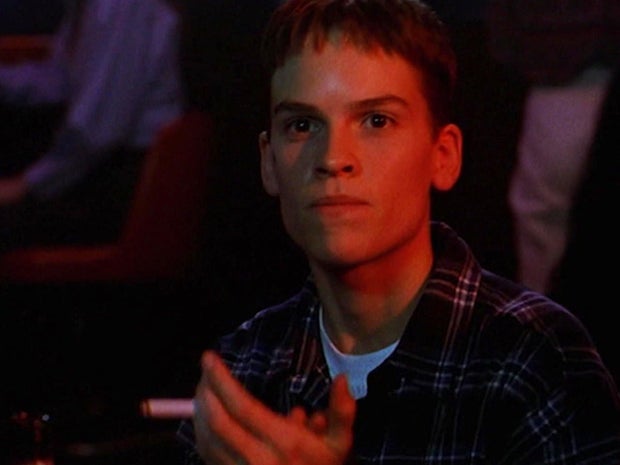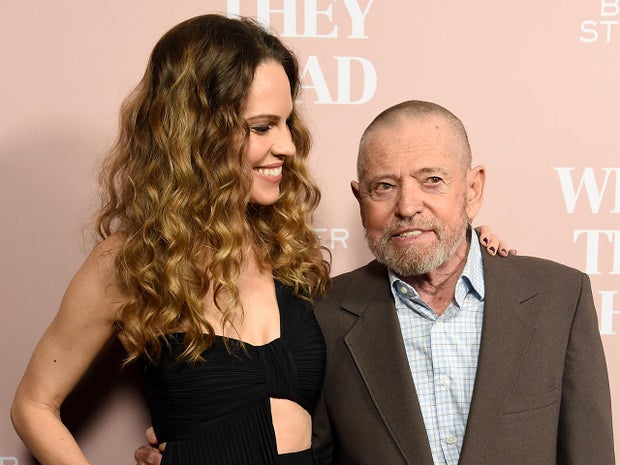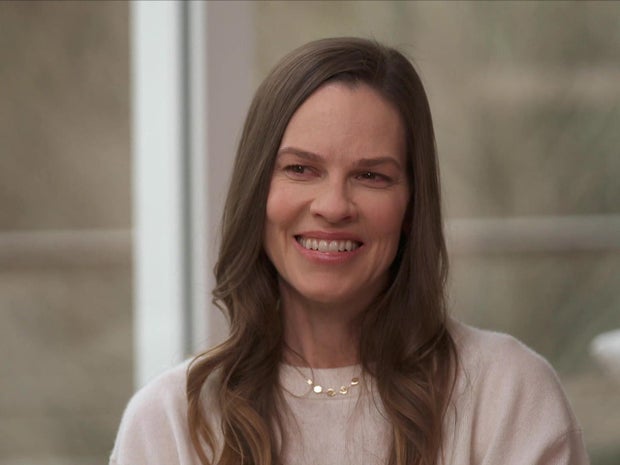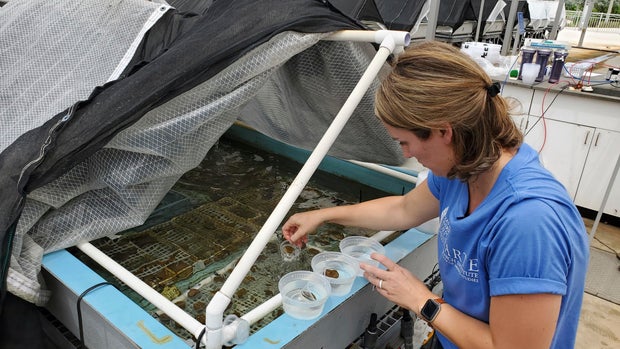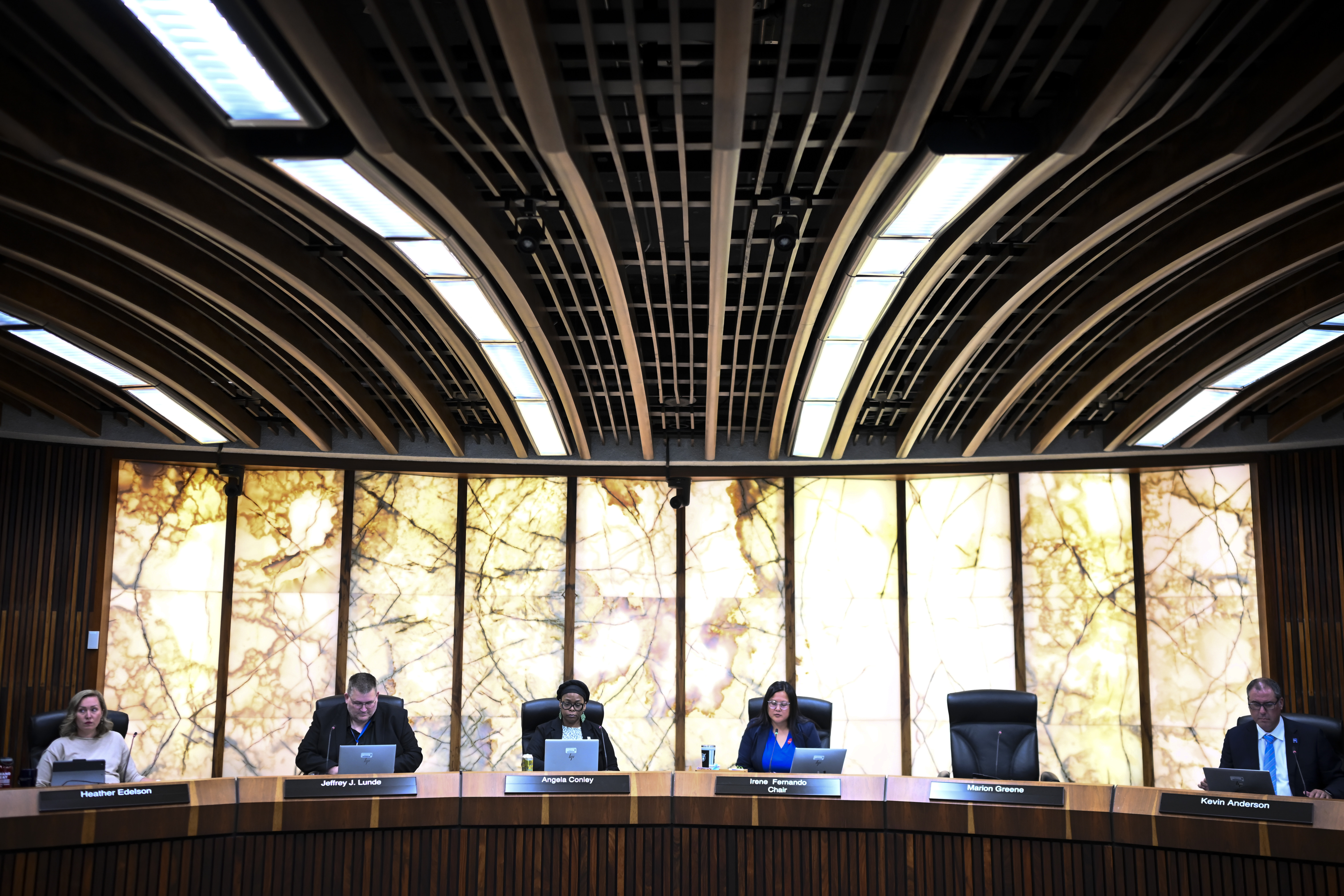CBS News
Hilary Swank on “Ordinary Angels” and miracles

In the most scenic corner of the Pacific Northwest, Hilary Swank is in her element. She has a lot of memories growing up here: “This lake right here is what I considered my best friend, because I spent every single sunny day in that lake,” she said.
CBS News
These days, the two-time Oscar-winner is staying on familiar ground, in her life and in her work. Her new film, “Ordinary Angels,” is the true story of a woman who moves mountains to help a little girl who needs a liver transplant, to the point of begging the hospital to erase the mounting medical debt.
For Swank, whose own father was a lung transplant recipient, the story hits painfully close to home. She started filming about five months after his death on October 1, 2021. “And so it was like, almost, I don’t know, kismet in a way, to be a part of it,” she said.
The movie is about a woman who tries to do the impossible, and keeps trying, until it happens.
To watch a trailer for “Ordinary Angels” click on the video player below:
The same could be said of Hilary Swank herself.
Raised in Bellingham, Washington, she grew up on the proverbial wrong side of town. Some kids at her school were told not to hang out with the kid from the trailer park. “Yeah, I don’t know – they didn’t want their kids playing with me. I don’t know. I know it’s stupid. It’s so silly.”
But it stayed with her: “Well, it stayed with me because, obviously, I didn’t understand it,” Swank said. “But it’s interesting, ’cause some of those people now, being back in the home town, were like, ‘Oh, I always believed in you.’ Yeah, I’m like, ‘No, you didn’t.’ I can’t keep my mouth shut to that!”
And their response? “That they don’t remember.”
And it seems she never forgot how tough it was to make it. For years she took any part, no matter how small. You might recognize her in “Growing Pains” with another struggling actor, Leonardo DiCaprio, who was on his way up, too.
ABC
“It was nine years of really hitting the pavement,” she said, “auditioning five times a day. And in the trunk of my car, it was all these different outfits that I would change and go in to be this different person in these auditions.”
And there was a lot of rejection. “You know, it’s a really hard thing to be told all the time, you know, about your looks and why you might not have gotten this or that. And you start to think, ‘Oh, do I need to change that about myself?’ And I think that was one of the reasons why – I didn’t realize consciously I was doing it, but I think I was looking for roles that weren’t about appearance, that they were really about people.”
And that turned out to be the key. In 1999 she landed a role that changed everything: “Boys Don’t Cry,” playing a real life trans teenager.
Searchlight Pictures
Swank was suddenly a name in Hollywood, with the fame, but not the fortune. Only paid $3,000 for “Boys Don’t Cry,” she had an Oscar but no health insurance. “At that time, you had to make $5,000 a year to have health insurance, and I didn’t,” she said. “I didn’t recognize that until I went in to try to get a prescription filled. And they were like, ‘That will be $260.’ And I was like, ‘Oh. I don’t think I need that prescription apparently!'”
Seems she’s had to fight for everything she’s ever had. In the role of a boxer for “Million Dollar Baby,” director and co-star Clint Eastwood had her bulk up her tiny frame with a brutal training routine, and more food than she’d ever eaten before. She consumed 60 egg whites a day. “I drank ’em!”
The movie also beefed up her reputation as a Hollywood heavyweight:
After winning her second Oscar, she continued to work. But in 2014, she put her career on hold to care for her father, recovering from a lung transplant. “It ended up being a little bit more, but I took three years off from my career,” she said. “I know a lot of people were like, ‘Oh, my gosh, how can you take that much time off of your career? Aren’t you worried about …?’ I’m like, ‘Worried about what? I’m only worried about my dad’s health.’
“And to think that, I don’t know, your career could go away or something was the least of my concerns, the absolute last thing.
“But it was such a great time,” Swank said. “We became even closer, obviously. And he’s one of my favorite people in the whole world. And I just, I miss him every day. And I would have only regretted not being there.”
Gregg DeGuire/FilmMagic via Getty Images
Sadly, her dad didn’t get to meet his grandchildren. Swank and husband Phillip Schneider welcomed boy-girl twins last year, just a few months shy of Swank’s 49th birthday. “They just turned ten months old, and I’ve been with them every single day,” she said.
In case you couldn’t tell from the title, “Ordinary Angels” is about how average folks can sometimes do miraculous things. Just looking at the career of its star, it’s tough to disagree.
When asked if she believed her own career has been miraculous, Swank said, “That’s a good question. So much of it, I think, is rooted in the fact that I loved it so much, but I also said, ‘I’m going to go do this.’ And I didn’t question it. I never said, ‘And if it doesn’t work out, I’ll do this, this, or this.'”
There was no backup plan? “No! I just never said I wasn’t gonna do it, you know? ‘Can’t’ was like a bad four-letter word in my house. So, if that is a miraculous thing, then, yes, I believe in miracles.”
CBS News
For more info:
Story produced by John D’Amelio. Editor: Lauren Barnello.
CBS News
“Beyond the Gates” cast announced: Tamara Tunie, Daphnee Duplaix, Karla Mosley star in Black-led CBS daytime drama

CBS has announced the first cast members for “Beyond the Gates,” which will become the first one-hour Black daytime soap to air on TV when it premieres early next year.
The show, set in an affluent Maryland suburb, centers around the Duprees, a prominent, multigenerational family. Tamara Tunie, Daphnee Duplaix and Karla Mosley have been cast as three key members of the Dupree family: the family matriarch and her two daughters.
Emilio Madrid; Getty Images; Karla Mosley
Tunie will star as Anita Dupree, a famous singer who raised two daughters with her husband, a former senator. Tunie starred as attorney Jessica Griffin on “As the World Turns” and as Dr. Melinda Warner on “Law & Order: Special Victims Unit.”
Duplaix will play the role of Dr. Nicole Dupree Richardson, Anita’s psychiatrist daughter whose life appears perfect from the outside. Duplaix is best known for her role on “One Life to Live” as Rachel Gannon, which earned her an NAACP Award nomination.
Mosley will portray Anita’s other daughter, Dani Dupree, an ex-model-turned-momager. Mosley was nominated for an NAACP Image Award for her role as Maya Avant Forrester on “The Bold and the Beautiful.”
“Beyond the Gates” will be the first new daytime drama to debut since “Passions” premiered in 1999.
CBS News
300 sea corals brought from Florida to Texas as part of effort to save the species

Dania Beach, Fla. — Scientists have moved about about 300 endangered sea corals from South Florida to the Texas Gulf Coast for research and restoration.
Nova Southeastern University and Texas A&M University-Corpus Christi researchers packed up the corals Wednesday at the NSU’s Oceanographic Campus in Dania Beach. The sea creatures were then loaded onto a van, taken to a nearby airport and flown to Texas.
Researchers were taking extreme caution with the transfer of these delicate corals, NSU researcher Shane Wever said.
“The process that we’re undertaking today is a really great opportunity for us to expand the representation of the corals that we are working with and the locations where they’re stored,” Wever said. “Increasing the locations that they’re stored really acts as safeguards for us to protect them and to preserve them for the future.”
Each coral was packaged with fresh clean sea water and extra oxygen, inside a protective case and inside insulated and padded coolers and was in transport for the shortest time possible.
NSU’s marine science research facility serves as a coral reef nursery, where rescued corals are stored, processed for restoration and transplanted back into the ocean. The school has shared corals with other universities, like the University of Miami, Florida Atlantic University and Texas State University, as well as the Coral Restoration Foundation in the Florida Keys.
Despite the importance of corals, it’s easy for people living on land to forget how important things in the ocean are, Texas A&M University-Corpus Christi researcher Keisha Bahr said.
David Fischer / AP
“Corals serve a lot of different purposes,” Bahr said. “First of all, they protect our coastlines, especially here in Florida, from wave energy and coastal erosion. They also supply us with a lot of the food that we get from our oceans. And they are nurseries for a lot of the organisms that come from the sea.”
Abnormally high ocean temperatures caused widespread coral bleaching in 2023, wiping out corals in the Florida Keys. Texas A&M University-Corpus Christi turned to NSU when its partners in the Keys were no longer able to provide corals for its research. Broward County was spared from the majority of the 2023 bleaching so the NSU offshore coral nursery had healthy corals to donate.
CBS News
“We’re losing corals at an alarming rate,” Bahr said. “We lost about half of our corals in last three decades. So we need to make sure that we continue to have these girls into the future.”
Texas A&M University-Corpus Christi is using some of these corals to study the effects of sediment from Port Everglades on coral health. The rest will either help the university with its work creating a bleaching guide for the Caribbean or act as a genetic bank, representing nearly 100 genetically distinct Staghorn coral colonies from across South Florida’s reefs.
“We wanted to give them as many genotypes, which are genetic individuals, as we could to really act as a safeguard for these this super important species,” Wever said.
CBS News
CIA officer who drugged, photographed and sexually assaulted dozens of women gets 30 years in prison as victims stare him down

A longtime CIA officer who drugged, photographed and sexually assaulted more than two dozen women in postings around the world was sentenced to 30 years in federal prison Wednesday after an emotional hearing in which victims described being deceived by a man who appeared kind, educated and part of an agency “that is supposed to protect the world from evil.”
Brian Jeffrey Raymond, with a graying beard and orange prison jumpsuit, sat dejectedly as he heard his punishment for one of the most egregious misconduct cases in the CIA’s history. It was chronicled in his own library of more than 500 images that showed him in some cases straddling and groping his nude, unconscious victims.
“It’s safe to say he’s a sexual predator,” U.S. Senior Judge Colleen Kollar-Kotelly said in imposing the full sentence prosecutors had requested. “You are going to have a period of time to think about this.”
Prosecutors say the 48-year-old Raymond’s assaults date to 2006 and tracked his career in Mexico, Peru and other countries, all following a similar pattern.
He would lure women he met on Tinder and other dating apps to his government-leased apartment and drug them while serving wine and snacks. Once they were unconscious, he spent hours posing their naked bodies before photographing and assaulting them. He opened their eyelids at times and stuck his fingers in their mouths.
U.S. Embassy and Consulates in Mexico
One by one, about a dozen of Raymond’s victims who were identified only by numbers in court recounted how the longtime spy upended their lives. Some said they only learned what happened after the FBI showed them the photos of being assaulted while unconscious.
“My body looks like a corpse on his bed,” one victim said of the photos. “Now I have these nightmares of seeing myself dead.”
One described suffering a nervous breakdown. Another spoke of a recurring trance that caused her to run red lights while driving. Many told how their confidence and trust in others had been shattered forever.
“I hope he is haunted by the consequences of his actions for the rest of his life,” said one of the women, who like others stared Raymond down as they walked away from the podium.
Reading from a statement, Raymond told the judge that he has spent countless hours contemplating his “downward spiral.”
“It betrayed everything I stand for and I know no apology will ever be enough,” he said. “There are no words to describe how sorry I am. That’s not who I am and yet it’s who I became.”
In October 2021, the FBI issued a notice to the public, seeking other potential victims of and additional information about Raymond, saying that some women depicted in the incriminating photos and videos remain unidentified.
In a statement Wednesday, authorities praised all the victims who came forward.
“The FBI thanks the brave women who shared information that furthered this investigation,” said
FBI Assistant Director in Charge David Sundberg of the Washington Field Office. “We recognize our domestic and foreign law enforcement partners who helped bring Raymond to justice for his reprehensible crimes.”
Raymond’s sentencing comes amid a reckoning on sexual misconduct at the CIA. The Associated Press reported last week that another veteran CIA officer faces state charges in Virginia for allegedly reaching up a co-worker’s skirt and forcibly kissing her during a drunken party in the office.
Still another former CIA employee – an officer trainee – is scheduled to face a jury trial next month on charges he assaulted a woman with a scarf in a stairwell at the agency’s Langley, Virginia, headquarters. That case emboldened some two dozen women to come forward to authorities and Congress with accounts of their own of sexual assaults, unwanted touching and what they contend are the CIA’s efforts to silence them.
And yet the full extent of sexual misconduct at the CIA remains a classified secret in the name of national security, including a recent 648-page internal watchdog report that found systemic shortcomings in the agency’s handling of such complaints.
“The classified nature of the activities allowed the agency to hide a lot of things,” said Liza Mundy, author of “Sisterhood: The Secret History of Women at the CIA.” The male-dominated agency, she said, has long been a refuge for egregious sexual misconduct. “For decades, men at the top had free rein.”
CIA has publicly condemned Raymond’s crimes and implemented sweeping reforms intended to keep women safe, streamline claims and more quickly discipline offenders.
Last year, the CIA announced the appointment of Dr. Taleeta Jackson, a seasoned psychologist who previously led the Sexual Assault Prevention Program at the U.S. Navy, as the new head of a dedicated sexual assault and prevention office at CIA.
“There is absolutely no excuse for Mr. Raymond’s reprehensible, appalling behavior,” the agency said Wednesday. “As this case shows, we are committed to engaging with law enforcement.”
But a veil of secrecy still surrounds the Raymond case nearly four years after his arrest. Even after Raymond pleaded guilty late last year, prosecutors have tiptoed around the exact nature of his work and declined to disclose a complete list of the countries where he assaulted women.
Still, they offered an unbridled account of Raymond’s conduct, describing him as a “serial offender” whose assaults increased over time and become “almost frenetic” during his final CIA posting in Mexico City, where he was discovered in 2020 after a naked woman screamed for help from his apartment balcony.
U.S. officials scoured Raymond’s electronic devices and began identifying the victims he had listed by name and physical characteristics, all of whom described experiencing some form of memory loss during their time with him.
One victim said Raymond seemed like a “perfect gentleman” when they met in Mexico in 2020, recalling only that they kissed. Unbeknownst to the woman, after she blacked out, he took 35 videos and close-up photos of her breasts and genitals.
“The defendant’s manipulation often resulted in women blaming themselves for losing consciousness, feeling ashamed, and apologizing to the defendant,” prosecutors wrote in a court filing. “He was more than willing to gaslight the women, often suggesting that the women drank too much and that, despite their instincts to the contrary, nothing had happened.”
Raymond, a San Diego native and former White House intern who is fluent in Spanish and Mandarin, ultimately pleaded guilty to four of 25 federal counts including sexual abuse, coercion and transportation of obscene material. As part of his sentence, the judge ordered him to pay $10,000 to each of his 28 victims.
Raymond’s attorneys had sought leniency, contending his “quasi-military” work at the CIA in the years following 9/11 became a breeding ground for the emotional callousness and “objectification of other people” that enabled his years of preying upon women.
“While he was working tirelessly at his government job, he ignored his own need for help, and over time he began to isolate himself, detach himself from human feelings and become emotionally numb,” defense attorney Howard Katzoff wrote in a court filing.
“He was an invaluable government worker, but it took its toll on him and sent him down a dark path.”




